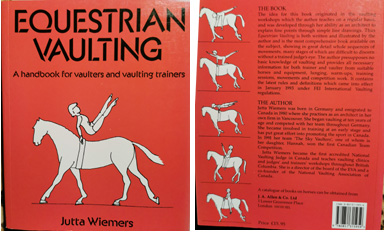Dear readers,
I get many questions still about the Equestrian Vaulting Handbook, which as you can see, has been out of print for some time. I am flattered that folks still want to read it. This book was written in 1991, came out in ‘94, and is therefore old -so not everything applies any longer, especially the competition rules, which have changed several times since. But the technique and mechanics used in the exercises are of course still correct, as are many of the rules I made for myself during my time as a vaulting trainer, such as how to motivate the children and deal with the vaulting parents in a club.
The book was originally written for prospective vaulters and trainers in countries where the sport was hardly known and access to information or workshops was scarce or not existing at that time. It included therefore a long catalogue of single and team exercises, instruction how to train a horse for this sport, how to lunge etc., which you can now research in more up-to-date publications. All that will not be repeated here. The book was however especially liked because of its many drawings, which show in detail how an exercise should be correctly performed, as well as how the common mistakes look – and what to correct, if and when the vaulter appears like that.
As I am a person, who basically stems from the Middle Ages, this means that I do NOT have the text of the book stored digitally! I must therefore re-type, or scan, or photograph pages and drawings and you have to excuse the quality of reproduction. I will do the best I can. And you get it for free!
Chapter 1 of the book was named: “Vaulting – how to start” and dealt with choosing a suitable kind of horse, the needed equipment for horse and children, and the trainer’s basic required knowledge of horses, gymnastics and coaching.
Chapter 2 was: “Most important Team Member: the Horse”, and Chapter 3 “How to train your vaulting horse”. If the horse choses to not participate, vaulting will be very difficult and dangerous. I would like to send you to my Blogs, where you can find out in depth how to treat your horse so he will like your training!
Chapter 4 was about the required vaulting equipment. No need to repeat that here – besides the rules might have changed.
But Chapter 5: “The vaulting child” and Chapter 6 “The vaulter’s parents” will be scanned in.
Chapter 7 was about “Lunging and the lunger”. As I have changed my opinions about lunging for a horse in training a lot over the years, I also send you to my Blog. Please try to make this job an enjoyable one for your horse! He should not expect boredom, as soon as he sees a circle… But as horses are still lunged during performance like before – except now on both hands – I will include this chapter.
Chapter 8 “You – the trainer”, Chapter 9 “Planning Training Sessions” and Chapter 10 “Training – what does it mean?” and Chapter 11 “Talent and Technique” are all still valid and really common sense. I also send you to my book “Stretch and Strength for young riders, vaulters and Mice” – a fun book to get the warm-up going!
I will stop here for the moment, but give you an overlook of what is to come later.
Chapter 12 and 13: Preparation before vaulting basically deals with how I shaped the warm-up for my vaulters. Mere running to get the muscles warm is not enough.
Chapter 14 will be scratched, as the rules have changed. So we’ll begin again with Chapter 15 to 22, where we’ll go through some of the compulsory exercises – as they stood when I wrote the book! So again: check what is valid NOW for competition – but this does not change the validity for the advice given here for correct technique of the exercises. Here you will see everything explained in line drawings, which I hope will help you greatly to visualize possible mistakes and remedies as well.
Once we will get this far – and that will take a while – we will see which of the chapters about the Kür and Team exercises are still applicable.


